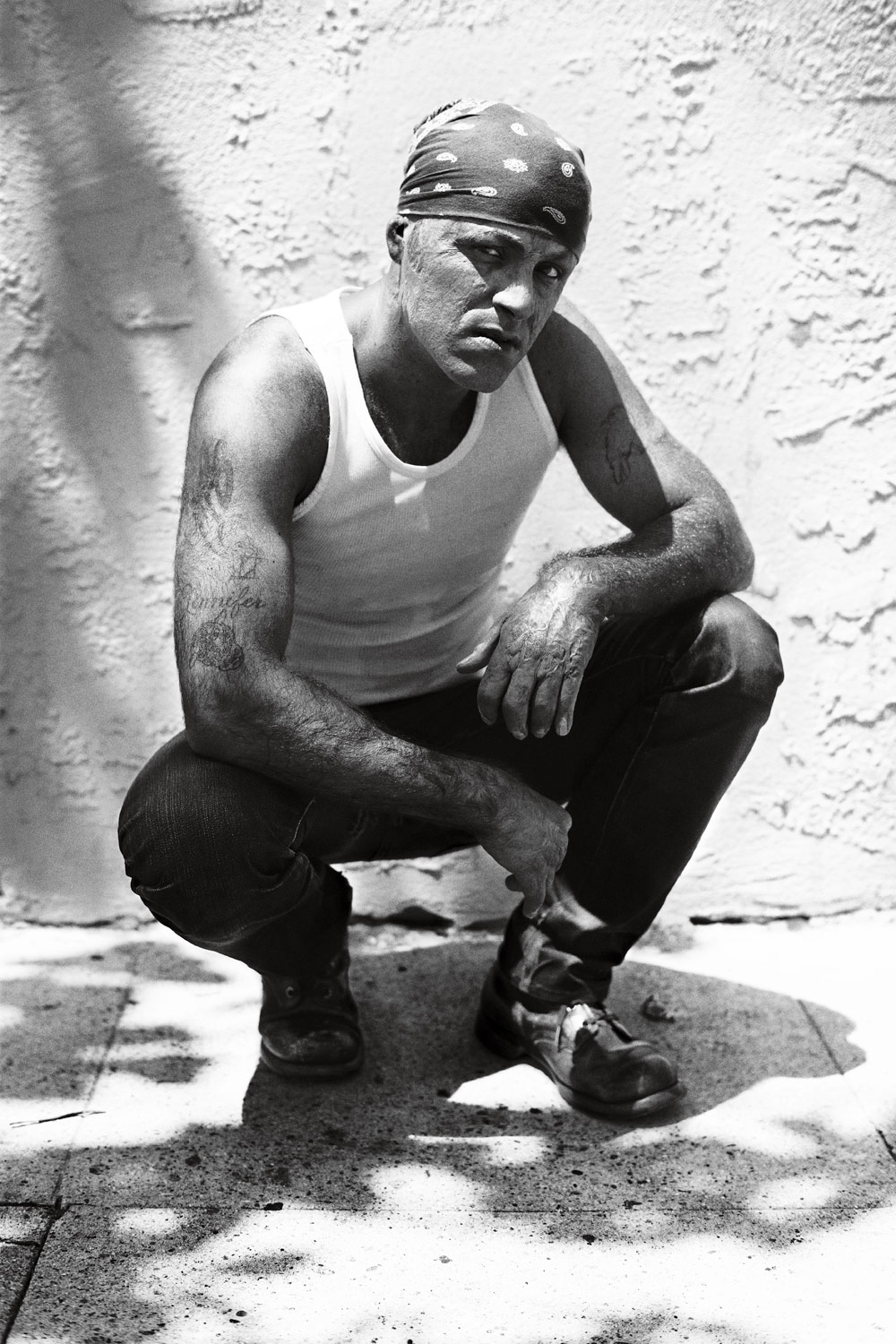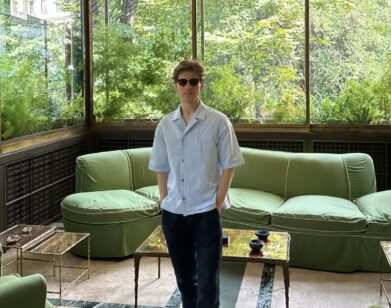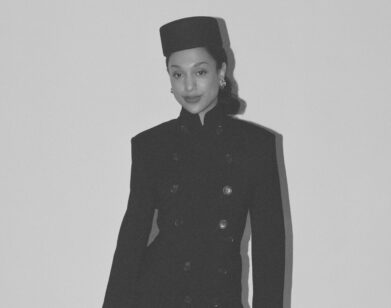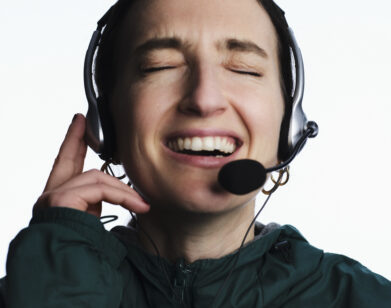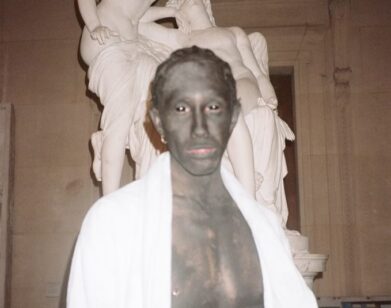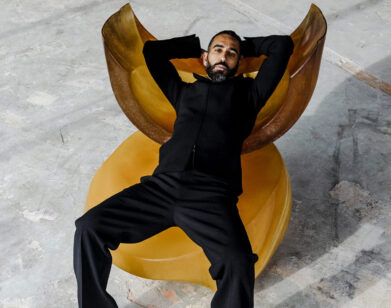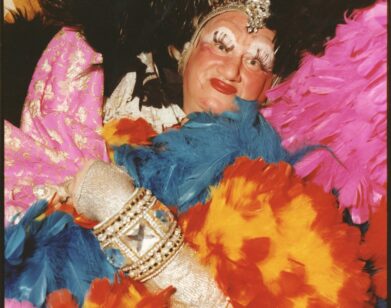Elad Lassry
For me, pictures have always had an innate nervousness about them. I think that the ghostlike quality of photography can never be explained.Elad Lassry
In a world engulfed in images, it is fair to assume that most people today have become experts in reading photography. Then, every once in a while, someone comes along and shakes us into the realization that our daily intake of photography is disturbingly passive and uncritically accepting. For the past few years, few people have reminded us to keep our wits about us in front of a frame better than Tel Aviv-born, Los Angeles-based artist Elad Lassry.
Lassry’s early pieces—many of them hyperclear studio still lifes of objects ranging from ceramic figurines and nail-polish bottles to live hawks and vegetables, all shot in rich colors and held in bright, contrasting frames—were evocative precisely because, on first look, they seemed innocent and unaggressive. Many of his photographs echoed magazine ads or stock photos from previous decades, which the viewer’s mind picks up as neutral territory. But Lassry’s sly aesthetic takes hybrid forms, and those early images were only camouflaged as visual safety zones. Clearly, something very strange indeed was going on inside these works.
Though Lassry may appear to be the progeny of the Pictures Generation (a popular inspiration for emerging artists of late), his work isn’t all that wrapped up with commercial imagery or the effects of mass media. His goals seem to be far more fundamental—directed at the way we read an image, the way an image is set up, framed, and devised—how we see. Almost as soon as he gained attention for his mounted two-dimensional studies, he moved away from the confines of print. He explored film with a number of projected video installations, capturing everything from actress Rose Byrne holding a California Kingsnake to visual perception tricks. Eventually, ballet dancers became a consistent subject. Then, in 2012, he ventured into three-dimensional mode. But even if his recent works involve actual dancers performing around colorful props in front of a live audience, he’s still investigating the photograph. In fact, Lassry sees these installations as pictures. Earlier this year, he staged a warm-up with dancers from the New York City Ballet at the Hayworth Theatre in Los Angeles. It was a small taste of the performance he is putting on this month at The Kitchen in New York City: rendering precise routines by 10 ballet dancers dressed in pop colors around equally bright props, Lassry takes his audience on an investigation of space, image, framing, spontaneity, reproduction, and formal rigor.
These days, Lassry, 34, contemplates such concepts at his house in Nichols Canyon in the Hollywood Hills, where he lives with his three dogs and two cats, as well as at his nearby studio. He managed to take a break from his preparations for the fall show to sit down with fellow L.A. artist Ryan Trecartin. Lassry’s dogs ran around nearby.
RYAN TRECARTIN: I was wondering why you like dogs so much. I used to be a dog person, but I’ve become very cats-only. Do you ever have fantasies about being a cat person instead?
ELAD LASSRY: But I am also a cat person. Haven’t you noticed? [Trecartin laughs] It’s true, though, that I have a much stronger connection to dogs. I own three dogs, one of which I’ve had since I was at CalArts. She’s a Chihuahua named Tuna Julia Kristeva—no relation to the theorist. I met her in what was probably an illegal pet store that I used to visit during depressed episodes. She was four months old and already heavily discounted. She was half off! But I was a student and couldn’t even afford that. I was as poor as it gets, but out of compassion, I asked to see her, and then I just couldn’t let her back into her vitrine. I wrote a bad check. She ended up attending CalArts seminars with me for my four years there. With my first paycheck, I purchased my proper kids—two standard poodles I named Jessica and Carter. Cats are different from dogs. The connection to a canine is much deeper and more psychological. I’m a bit attracted to Great Danes. Is that sick?
TRECARTIN: Not sick at all. Getting onto the subject of art, I saw your show in L.A. last March, which was a prelude to the piece you are doing in the fall at The Kitchen. I remember that when I walked into the space, I was struck by your architectural tools. They felt less like an intervention and more like a lubrication, if that makes sense. It added an additional way of reading your work—like the set pieces in the performance framed the dancers almost like live pictures. For me the props felt like user-friendly applications, and I kind of thought of my phone, actually.
LASSRY: I never think of those pieces as architectural interventions, so I’m glad you had that experience. The idea of making those sculptures was to activate the consciousness of looking and ways of looking. My work started in the traditional form of photography—they were photographs, prints, or framed found images. But I think all along I was introducing a picture and asking for the image to open up and be looked at as an object. After a number of exhibits, I was interested in creating a larger, “live” picture with these sorts of partitions that offer apertures. And I like how basic the sculptures are. They’re just cut out and very hands-on. In a way, the sculptural pieces are much simpler than the photo-based works, especially when you consider how many technologies are in play in the photographs. For example: the archival 35-millimeter negatives of [the late actor] Anthony Perkins, which have been heavily manipulated and digitally printed. And I always think there’s a sense that all of these technologies could just fail. I like that tension.
TRECARTIN: When I look at your photographs, I get the sense that you see history as incredibly malleable—like history is a virtual space as malleable as the present or the future. But I know a lot of people see your work as nostalgic because you use these archival images and advertisement—like props. But it seems like nostalgia is not your end goal.
LASSRY: When I was starting out, conceptual photography had become something that had to be amateur—like, that had to be black-and-white, or photocopied, or really not an object in order to be taken seriously. It had to work against technical mastery, and so on. So I think that my work is full of obstacles in the sense that it does look highly familiar and accessible. It does look like it’s already “solved at first sight.” It does look like it’s part of a larger industry. There are all these clues in the initial interaction with the work that offer a safe space, and of course, they collapse very quickly, depending on how much you engage with the work. I used to refer to my photos as free radicals—and maybe that has to do with this idea of navigating history. I think of the works as having this dormant illness that can really latch on to different histories. So they can exist in a world pretending to be neatly encapsulated, already framed, and fixed. But actually they are these parasites dependent on the failure of modernist history and on multiplicity. I think there’s a general confusion that my work is about types of photography. But really that’s just a tool to introduce some questions I have about seeing. What happens when all of these conditions and structures and histories and cultures and tools you have around you begin to fail? On the one hand there is an engagement with histories and cultures, and on the other, there is this very lonesome space of actually coming to terms with seeing.
TRECARTIN: Coming to terms with seeing is like a moment in your childhood when you realize that you don’t have to see things like everybody else, that there really aren’t any universal ways of seeing, even if you’re being taught that there are.
LASSRY: Yes. That moment where you realize your experience is not shared with the group, or the school, or the collective.
TRECARTIN: How does that relate to working with dancers?
LASSRY: The performance is really meant to be this ignition, this sort of start-up of a state of mind. The performance is really about making a picture without a camera. It kind of grew out of the films I was making. Just like my photographs, the films were potentially very corny, or again too familiar, too saturated, too heightened. It was creating this nervousness about what it means to represent a subject in this way. And not just the subject, but also the space around it-since the films weren’t stable images, but projections on a wall. So it’s really the same for the performance. You sit down and you look at something that has gone through a mediation, a lens. However, there is no camera. It’s an actual presentation. But the presentation looks pre-made, already composed.
TRECARTIN: When [artist] Lizzie Fitch and I saw your performance, we were struck by how much it reminded us of your photographic work rather than your film work, just because there was always this sense of the frame. It’s interesting how much you use dancers. It doesn’t feel like you have an obsession with dance. It seems like your interest is more with choreography and the act of remembering movement.
LASSRY: What I found interesting in dance is the idea that my work has always been dealing with the nervousness between the human subject as a subject and the human subject as a form. And if you look at my dance films, there are always these cuts between the dancer as a form, the dancer as a subject, and this kind of very harsh treatment of the dancer as someone who’s actually drawing with their body. But dance became this very fascinating occasion in which a group of individuals are being treated as a troupe and are sort of making a picture together; yet there are these moments where each dancer can also function by themselves and potentially take over the picture or dismantle the picture. That was where I found the nervousness. It’s like a school of fish. Or a herd of—what can be a herd?
TRECARTIN: Deer. Or sheep?
LASSRY: Sheep. [laughs] No, that’s not right. But it’s making a picture out of something that is so rich in history, so iconic, so esteemed within culture, and shoving all that to the side and asking it to become abstracted. The first dance film I made with the New York City Ballet was Agon in 2007. Balanchine did not want it to be released on film. He was very controlling about what was to be released because he was very aware of how different the representation of the dance is on film than watching it performed live. The dances that he did release were all specially choreographed by him for the camera. So when I made that film, I picked Agon, which was the first dance Balanchine choreographed for a black dancer in a principal role, Arthur Mitchell, in 1957. Balanchine choreographed for individual dancers. He’d get very inspired by a particular dancer and would create a dance for them. Agon is a pas de deux between a black dancer and white dancer. That was quite provocative, because at that time ballet was not known for its history of inclusion. Ballet was basically very Aryan in its culture. This dance also had a rigid high modernism, this neoclassical-meets-modernist tradition. It was very progressive for its time. And since there was no tape of it, all I could look at were photographs. So my film of Agon is seven variations on the last minute of the pas de deux. I filmed in the rehearsal space of the New York City Ballet, and all the studies for my piece were old photographs. I’m not really interested in diving into the whole history of the dance. I’m more interested in just having the viewer feel the ghost of that history. The ghost of the picture—which is the rehearsal performance I filmed. The status of this piece isn’t nostalgia. The status is contemporary technologies, or the different avenues that a picture goes through today. For me, pictures have always had an innate nervousness about them. I think that the ghostlike quality of photography can never be explained—that film doesn’t even need to depict a dance. I could have made that work with football players using the same strategies.
TRECARTIN: On first glance, your works give the sensation of stock photography, rebranded, presented almost like logos, and then it all collapses and becomes art again.
LASSRY: It’s a bit like sneaking . . .
TRECARTIN: That, and it’s a perverted feeling.
LASSRY: I think it’s the result of being an outcast, like trying to sneak in to the party and then they realize that they let the wrong person in. [laughs] So, in terms of the photos, they do engage with what could be stock. And they do engage with canonical ideas of circulation. Once they enter the system—like a virus—they sort of turn on the viewer.
TRECARTIN: I used to do ballet.
LASSRY: No way! When?
TRECARTIN: Growing up. It was in Ohio. I danced from the second grade until the eighth grade.
LASSRY: How cute. Can you do any moves now?
TRECARTIN: No. Do you dance?
LASSRY: I have too much respect for ballet to dare practice it. I did ask ballerina Megan LeCrone to teach me jetés. She said that was impossible but did observe that I have great feet.
TRECARTIN: When I was watching your performance, I had all of that baggage from training in dance. And yet, your effect worked because even with all of my memories, I still saw it all in pictures. I didn’t think about dance too much. Because there was no music, I started looking at the dancers really intensely—at their faces, looking to see them in detail as you were framing these fluid forms. I guess that’s why in the films you do, you capture them while they are rehearsing. You capture the kind of rehearsals that are more about spotting-totally silent, the sound is in seeing movement remembered. And there’s no narrative. Just parts that have been memorized.
LASSRY: Well, it’s definitely been interesting to work with a group of people with a mastery in dance. And I needed to use their mastery, their skills. However, they needed to realize that I’m not making a dance, which is what they are used to making. That’s their job. It’s this moment where the dancer truly becomes a form, when they are no longer producing what they have been trained to enact. It’s hard to tell a dancer to function like a picture. [laughs]
TRECARTIN: When you are dating someone, do they ever ask you to take their picture? And does that make you annoyed or happy or sexual or what?
LASSRY: Since I switched to an iPhone, I did start taking pictures of people I like. Until then, I strangely never took pictures. I think the iPhone became this space that was different enough from a “photograph,” so I find myself taking pictures of daily things. If someone I dated asked me to take their picture, I would most likely find it disturbing. Perhaps nude pictures would be fun. But that would have to be on an iPhone. I can’t make Edward Westons.
TRECARTIN: What about apps like Instagram? Do you participate?
LASSRY: Instagram is not an option for me. I have an Instagram—like relationship with a few people, some of whom I’ve only met once. We e-mail each other a picture every week. But I cannot deal with posting it. It’s a very personal message for me.
RYAN TRECARTIN IS A LOS ANGELES-BASED ARTIST AND A CO-CURATOR OF THE NEW MUSEUM’S 2015 GENERATIONAL TRIENNIAL.

